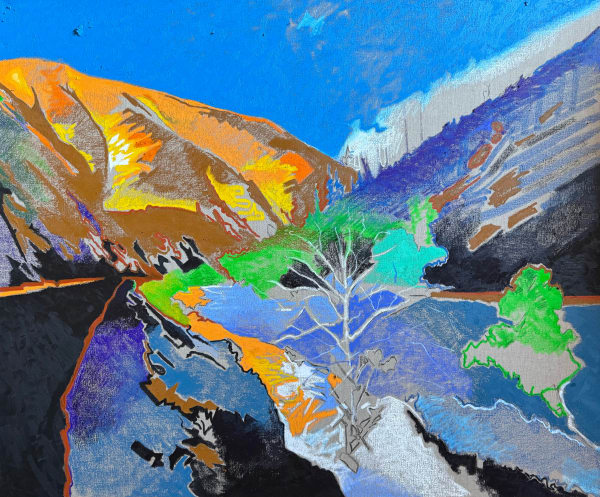James Vaulkhard English, b. 1986
James Vaulkhard holds a BA degree in History of Art from Leeds University, and has both trained and taught at Charles Cecil Studios and Studio Della Statua in Florence, Italy. Here, he gained a formidable reputation for his ability to embrace and manifest traditional techniques in both portraiture and sculpture. Notably, upon his graduation in 2013, Vaulkhard was commissioned to participate in a bridge project between Italy and Kenya, developing the preliminary studies for The Sacred Heart Cathedral Kericho in collaboration with local Kenyan sculptors.
In 2014, Vaulkhard relocated to London and continued to develop an artistic style that reframed his classical training and moved towards a more experimental category of visual expression. His first work to be exhibited in London was a series of collage works featuring seven representations of the fictional hero James Bond comprised of found erotic and pornographic imagery. In the wake of the success of that series he created a series entitled Icon that employed the same techniques. This included his acclaimed unauthorized 2017 portrait of then-President of The United States Donald Trump, created from cuttings of historical dictators and political tyrants.
In 2019, Vaulkhard returned to his roots in oil painting, creating a large-scale series of dystopian landscape paintings entitled Echo Chambers–a collection of algorithm-inspired ‘cave-paintings’ that posed questions about human identity in an era that the artist suggests may prove to be the dawn of guided evolution. These abstract forms blended a primordial past and potential future, depicting fingerprints and crude depictions of beasts veined in algorithmic code.
In his most recent work, Vaulkhard has combined techniques developed in both these series of works and married them to the aesthetic arena of Japanese art, specifically addressing the mysterious concept of Ma or negative space. The result is a series of abstract landscapes intended to draw the viewer deeper into nature via an overwhelming visual cacophony that seeks to communicate the vast potentialities that exist between the elements.
James Vaulkhard’s paintings are illuminations of hope, they lead us to a potential for growth that sheds light on a flourished future. The artist draws inspiration from the Japanese theory of MA, coordinating the literary concept with a prodigious knowledge of Florentine classical canons of depth, embodied by shadows, reflections and light.
James has been developing this body of work over the last two years, drawing his inspiration from landscapes in both Singapore and Kenya. The works are best described as dreamscapes, in the most noble sense of the term: they are landscapes mused from memories.
His works echo an abstraction that can be found in Claude Monet’s Water Lilies. Similarly to the French artist, James’ works capture a constantly changing natural light and colour, which dissolves all spatial cues and where adjacent elements intermingle. Each painting is a token for a balmy meditative moment. The physical occurrence of water lilies also reflects upon a peaceful overtone, describing an ascension from the worldly to the spiritual. Vaulkhard’s works are an omen that touches on metaphors of the living and the lost.
James propositions the viewer with a rediscovery of the meaning of space, how it is occupied and how it overflows with the weight and light of the ethereal. The works are a portrayal of our geo-psyche. He manifests hidden spirits and makes them reappear as bloom on the canvas.
His oeuvre shows us that nature is abstraction. Foliage is a palette for the artist to play with and the patterns in verdure are the stencils of the human spirit, constantly repeated and adapted to the canvases of our lives. These carvings of nature lead way to negative spaces charged with even more abstraction: “the silence between the notes which make the music”.
In his most recent body of work, James develops on his approach to the concept of MA, he talks about the legacy of the forest surrounding his home in Kenya. His work has strong visual references to Peter Doig and David Hockney. His use of colour is emotional, as opposed to being a representative one. His use of purple hues are echoes of nature and the memories which it holds. James’ palette tells a different story to the one which can be seen in his compositions. The hues are evocative of memories, they aren’t descriptions of nature, but of the nostalgia which it conveys. Similarly to Doig, James is a voyeur to his environment, a painterly novelist of the sceneries surrounding him.
-

The Emergent and the Iconic | Gallery Artists
7 Piccadilly Arcade 21 Aug - 28 Sep 2025The Emergent and the Iconic brings together two distinct yet interconnected forces in contemporary art: the established mastery of internationally celebrated artists and the compelling, often unpredictable, vitality of a...Read more -

James Vaulkhard | The Sublime and The Consumed, An American Pastoral
Gallery Exhibition | 7 Piccadilly Arcade 10 Apr - 13 May 2025James Vaulkhard’s practice merges classical precision with contemporary abstraction, creating a dynamic interplay between figuration and fragmentation. His compositions, rich in bold hues and intricate textures, explore themes of memory,...Read more





